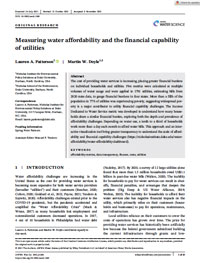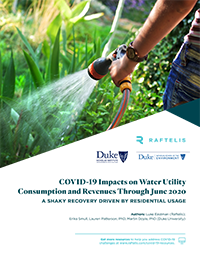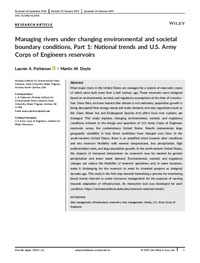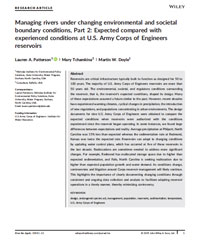Beplay全站app
Measuring Water Affordability and the Financial Capability of Utilities
The cost of providing water services is increasing, placing greater financial burdens on individual households and utilities. Five metrics were calculated at multiple volumes of water usage and were applied to 1791 utilities, estimating bills from 2020 rates data, to gauge financial burdens in four states. More than a fifth of the population in 77% of utilities was experiencing poverty, suggesting widespread poverty is a major contributor to utility financial capability challenges.
2020 Aspen-Nicholas Water Forum Water Affordability and Equity Briefing Document
This paper explores the evolution of water services in the United States. Most people have access to water, most tap water is drinkable, most dams are secure, most farms can grow more with less water, and most rivers are cleaner than they were 50 years ago. Most does not mean all. There is growing evidence that an increasing number of Americans are losing access to safe drinking water and sanitation—and others never had it at all.
COVID-19 Impacts on Water Utility Consumption and Revenues Through June 2020
May and June 2020 data for the eight water utilities in our study show diverging trends of water consumption and revenues as the COVID-19 pandemic continues, with states and local governments taking different approaches and timelines to rolling back restrictions. There are signs of recovery in water consumption and revenues for many utilities, mostly due to high residential consumption and billed revenues, not increased usage from non-residential customers.
Harnessing Data Analytics to Accelerate Energy Access: Reflections from a Duke-RTI Convening on Data for Development
One of the defining features of our current era is the proliferation of innovative technologies that constantly generate data and information. Earth observation satellites, ground-based tools such as vehicle-mounted cameras, smart meters, and crowd-sourced platforms all collect and gather data with applications for the energy sector.
Federal Decentralization and Adaptive Management of Water Resources: Reservoir Reallocation by the U.S. Army Corps of Engineers
Reservoir operations must respond to changing conditions, such as climate, water demand, regulations, and sedimentation. The U.S. Army Corps of Engineers (Corps) can reallocate reservoir storage to respond to such changes.We assembled and analyzed a database of reservoir reallocationsimplemented and proposed by the Corps.
Trends in Measuring Biodiversity and Ecosystem Function in Mitigation Quantification Methodologies
Over the last decade, efforts to use compensatory mitigation to manage and ameliorate the impacts of development on biodiversity and ecosystems around the world have accelerated. Mitigation mechanisms provide a structured way to advance economic development and infrastructure while also achieving environmental goals. In order to operationalize mitigation programs, practitioners need a methodology for calculating or quantifying impacts and offsets (debits and credits). The methods currently employed in the U.S. and abroad are extremely varied. Surprisingly, the literature on best practices or standards for developing science-based approaches to the quantification of impacts and offsets is sparse and there is also no single broadly accepted best practice guidance.
Managing Rivers Under Changing Environmental and Societal Boundary Conditions, Part 1: National Trends and U.S. Army Corps of Engineers Reservoirs
Most major rivers in the United States are managed by a system of reservoirs; many of which were built more than a half century ago. These reservoirs were designed based on environmental, societal, and regulatory assumptions at the time of construction. Since then, we have learned that climate is not stationary, population growth is being decoupled from energy needs and water demand, and new regulations (such as the Clean Water Act and Endangered Species Act) affect how river systems are managed.
Managing Rivers Under Changing Environmental and Societal Boundary Conditions, Part 2: Expected Compared With Experienced Conditions at U.S. Army Corps of Engineers Reservoirs
Reservoirs are critical infrastructure typically built to function as designed for 50 to 100 years. The majority of U.S. Army Corps of Engineers reservoirs are more than 50 years old. The environmental, societal, and regulatory conditions surrounding the reservoir, that is, the reservoir's expected conditions, shaped its design. Many of these expectations assumed a future similar to the past. However, recent decades have experienced warming climates, cyclical changes in precipitation, the introduction of new regulations, and populations concentrating in urban environments.
Addressing Declining Appropriations for Bureau of Reclamation Infrastructure: Policies Needed for Enabling Private Finance
Western water infrastructure was funded in the early and mid‐20th Century with federal financing through the Bureau of Reclamation. Over the last 30 years, federal financing has been less forthcoming, which has been commensurate with an increase in the need for financing rehabilitation and replacement of western irrigation infrastructure. This article in theJournal of the American Water Resources Associationsuggests that if the Office of Management and Budget changed its policies for private partnerships or loan guarantees, private capital could play an important role in recapitalizing aging Reclamation infrastructure.
Leveraging Big Data Towards Functionally-Based, Catchment Scale Restoration Prioritization
To address limitations to stream and wetland restoration projects, there is a critical need for a functionally-based, high-resolution restoration priority system that can be implemented at broad spatial scales to maximize ecological benefits. This article in the journalEnvironmental Managementdescribes the River Basin Restoration Prioritization tool developed in conjunction with the North Carolina Department of Environmental Quality to incorporate data models into a catchment scale restoration prioritization framework. It is designed specifically as a state-wide screening tool that assesses hydrologic, water quality, and aquatic habitat quality conditions with peak flood flow, nitrogen and phosphorus loading, and aquatic species distribution models. Although the application of the tool in this analysis is for the state of North Carolina, the methodology and model datasets are readily applicable to other states or regions to assess a large volume of data to better inform restoration choices.










